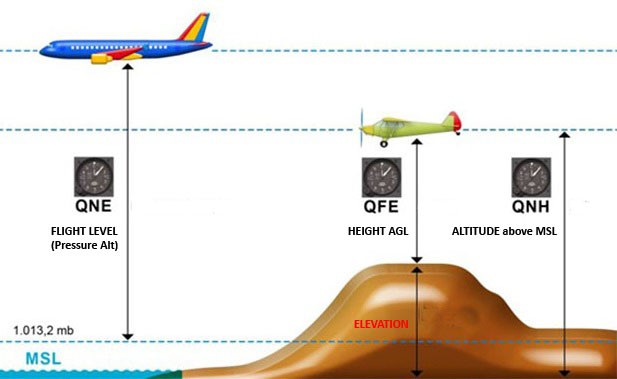Your altimeter is a simple, yet essential instrument, and setting it correctly is important in order to get accurate readings. Most airports have a published transition altitude, and this is the point, when in a climb that you would change over from the local QNH setting to the QNE, or standard setting of 1013hPa. But what is the actual effect of this change?
Firstly, all altimeters are calibrated according to International Standard Atmospheric (ISA) conditions. This is understandable, so that the effect of changing altimeter settings will be common to every aircraft. In this instance, we will focus on the two principle sub-scale settings of QNE and QNH.
What is the difference between QNE and QNH?
QNH the barometric pressure at a station, corrected for Mean Sea Level (MSL). This means that Indicates correctly at the airfield reference point, in other words, it will show the height of the airfield above MSL. QNE, is a specific setting of 1013hPa, and is used by aircraft flying above the transition altitude, and provides a common datum for aircraft flying above this level. Both QNH and QNE are pressure altitudes, but they have different reference points.
So, what is the effect of changing between these settings?
The best way to demonstrate this, is by means of example:
When landing at an airport you have correctly set QNH 1023 hPa as the reference pressure on your altimeter. The altimeter indicates 1200ft after landing. Suppose that you change the pressure reference to the standard setting 1013 hPa, what will your altimeter indicate approximately?
Looking at the above picture, you can see that QNH is measured from MSL, whereas the reference point for the QNE setting only starts at the 1013 hPa pressure level. The fact that the line at QNH is longer, indicates that we will have a higher altitude with QNH set than with QNE set, therefore, the indication with QNE set will be lower:
1023 – 1013 = 10 x 30 ft = 300ft
1200 – 300 = 900ft
Here is a second scenario:
During the climb, after take-off, the altimeter setting is adjusted at the transition altitude. If the local QNH is 1023hPa, what will happen to the altimeter reading during the resetting procedure?
Even though the pressure of 1023 hPa is higher (so theoretically we should be lower), REMEMBER that the starting reference point of QNH is MSL, so the altimeter indication will show a greater altitude indication than if we have 1013 hPa set. Therefore, once we change over to a 1013 setting at the transition altitude, our altitude indication will decrease.
As you can see, forgetting to change the setting, particularly during a descent through the transition level, could have serious consequences, not only with other traffic, but also with terrain clearance.





Your first scenario answer is supposed to be 1500′
Since 1023 pr happens at a lower height and 1013mn happens at higher height given that Pr reduces as we go up
Well explained !